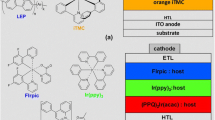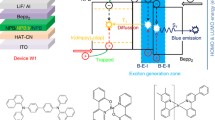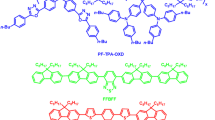Abstract
White organic light-emitting diodes (WOLEDs) are ideal candidates for next generation solid state lighting. In order to overcome that operational stability limitation of all phosphorescent material based OLEDs, hybrid WOLED with a combination of blue emitting florescent and phosphorescence based other color emitting systems are used. In this study, hybrid WOLED by fabricating WOLED devices with varying dopant concentration and layer thickness were fabricated and tested for their performances and stability. The power efficiencies of the devices were found to vary from 3.43 to 16.5 lm/W and devices showed a wide color range from cool white (CIE—0.34, 0.42) to warm white (CIE—0.47, 0.48) and moving towards yellow color. The devices fabricated over an area of 16 mm2 showed good performance and color stability at constant current driving and showed lifetime of T90 of 60 min at brightness of 3000 cd/m2.
Access provided by Autonomous University of Puebla. Download conference paper PDF
Similar content being viewed by others
1 Introduction
In recent years, Organic light-emitting devices (OLEDs) have shown great potential for full-color displays, backlight for liquid-crystal displays and solid state lighting. White organic light-emitting diodes (WOLEDs) are an ideal candidate for the solid state lighting over other technologies due to their advantages such as large area surface diffusive emission, potentially low cost manufacturability and eco friendliness. For solid state lighting applications, WOLEDs should have good color coordinates and color rendering index (CRI > 80), in addition to high power efficiency and long operational lifetimes [1]. Being current driven devices, OLEDs can be operated at very high luminance at increased current densities. However, the operational lifetime of a device was found to reduce drastically at high current densities, due to different failure mechanisms such as material decomposition and joule-heating.
In order to achieve high power efficiency and performance, highly efficient phosphorescent OLEDs (PhOLEDs) are being developed. In OLEDs, light is emitted by the recombination of holes and electrons in the emitter molecule layer. The recombination generates singlet and triplet excitons in the ratio of 1:3. In fluorescent emitter molecules, the singlet excitons emit light whereas, triplet excitons undergo non-radiative transitions without contributing to light emission. [2] In order to overcome this limitation and to utilize triplet excitons for light emission, phosphorescent emitters based on organometallic rare earth metal complexes with Iridium (Ir-) or Platinum (Pt-), which induce spin orbit coupling. Thus, by using phosphorescent emitters, OLEDs can operate with internal quantum efficiency close to 100%. Even though researchers have shown high performance and lifetimes in red, green and yellow color emitting PhOLEDs, blue PhOLEDs are known for lower lifetimes [3,4,5,6].
For white light emission, color mixing is the most widely used method. White emission can be obtained by mixing two complementary colors (blue and yellow) or three primary colors (red, green and blue). Various techniques have been reported for producing white light by color mixing [6]. Among them, one of the most promising techniques is the use of stacked WOLEDs, which connect individual color emission units. It helps to produce various hues and stable color can be achieved over a wide range of driving currents. In our previous studies, we have found out that a fully phosphorescent WOLED can produce very high performance, but the operational lifetimes of the devices are very low.
In order to achieve good stability and longer lifetimes, a hybrid WOLED which employs both fluorescent and phosphorescent emission systems is needed. Even though, the introduction of blue fluorescent emitter limits the power efficiency and performance of the WOLED, with optimal design of the stack through charge balance and recombination zone control, good performance and color stability can be achieved using bi-layer hybrid structure. In this study, we have developed hybrid WOLED using a bi-layer of blue fluorescent and yellow phosphorescent emitting host-dopant systems. A fluorescent host and dopant were used for blue emission, whereas, widely used host, 4,4′-Bis(N-carbazolyl)-1,1′-bipheny (CBP) and a high performance yellow phosphorescent dopant, Iridium(III) bis (4-phenylthieno [3,2-c] pyridinato-N,C2-) acetylacetonate (PO-01) were used in the fabrication of bi-layer hybrid WOLED [7,8,9].
2 Materials and Methods
OLEDs were fabricated on 0.7 mm thick glass substrates coated with 150 nm thick Indium Tin Oxide (ITO).The substrates were cleaned in deionized water, isopropyl alcohol and dried. Further, the layers were patterned and pixelated using photolithography. Afterwards, the substrates were exposed to argon-oxygen plasma for removing any impurity and ITO work function improvement prior to deposition. The sequential deposition of all the organic and metal layers were carried out in high vacuum thermal evaporation cluster tool, under a vacuum of 10−8 Torr. The fluorescent blue host, dopant and HIL were purchased from DOOSAN electronic materials, Korea; while CBP, N,N′-Di(1-naphthyl)-N,N′-diphenyl-(1,1′-biphenyl)-4,4′-diamine (NPB) and 2,2′,2″-(1,3,5-Benzinetriyl)-tris(1-phenyl-1-H-benzimidazole) (TPBi) were purchased from E-Ray optoelectronic materials, Taiwan; PO-01 was purchased from Lumtec corporation, Taiwan and Lithium Fluoride (LiF) was purchased from Sigma Aldrich. The thickness of layers, deposition rates and doping concentrations were controlled and measured in situ using calibrated quartz crystal based thickness monitors. The deposition rates of all the organic layers were 0.1 nm/s and LiF was deposited at 0.01 nm/s. After deposition, the OLEDs were immediately encapsulated using glass with an UV curable epoxy and were characterized (Fig. 20.1). The characterization of the devices was done using Keithley 2400 source meter and spectroradiometer (Konica Minolta CS1000) at room temperature.
3 Results and Discussion
For commercial lighting applications, OLED should have a brightness of more than 1000 cd/m2 with a lifetime (T70) in the order of thousands of hours. So, all the devices were tested at brightness 1000 cd/m2 or higher. The fluorescent blue emission stack was previously optimized to achieve a power efficiency of 2 lm/W and current efficiency of 3.9 cd/A with a very good operation stability in terms of both color and performance. The blue OLED (Device-B1) has turn on voltage of 4 V, with a peak luminance of 15,000 cd/m2 at 10 V with color co-ordinates (0.17, 0.20). Since, the blue fluorescent OLED was already optimized and known, the yellow phosphorescent OLED was fabricated with different concentrations of yellow dopant in the same stack. The yellow phosphorescent emission OLEDs with different concentrations of yellow dopant was optimized. The devices with structure: ITO/HIL/NPB/CBP + PO-01(x)/TPBi/LiF/Al/protective layer were fabricated with concentration, x varying from 5 to 15 wt% in the CBP host layer. The device D1 fabricated with 5 wt% concentration of yellow dopant achieved brightness of 1120 cd/m2 at a voltage of 6.5 V with CIE co-ordinates (0.48, 0.49) with a current efficiency of 27.7 cd/A and power efficiency of 13.4 lm/W. The device D2 with 10 wt% dopant concentration performed with an operational voltage of 6.0 V at a brightness of 1380 cd/m2 with CIE co-ordinates (0.507, 0.487) with a current efficiency of 34.7 cd/A and power efficiency of 18.2 lm/W. Whereas, the device D3 with 15 wt% concentration of dopant achieved a brightness of 1080 cd/m2 at a voltage of 6.0 V with CIE co-ordinates (0.52, 0.47) with a current efficiency of 36.1 cd/A and power efficiency of 18.9 lm/W on a device area of 16 mm2 (Fig. 20.2)
Progressively, the devices were tested for lifetime under constant current conditions at higher brightness level of around 3000 cd/m2 for stability. The device D1, when tested at brightness of initial luminance of 3200 cd/m2 and the luminance value dropped to 2710 cd/m2 with voltage changing from 7.98 to 8.48 V in one hour of testing. While device D2 showed a slightly better performance, with brightness dropping from 3130 to 2650 cd/m2 with operational voltage changing from 6.83 to 7.21 V in a span of one hour. Further, the device D3 when tested, the luminance dropped from 3180 to 2250 cd/m2 with voltage changing from 7.25 to 7.53 V (Fig. 20.3).
It was observed that, with the increase in the concentration from 5 (D1) to 10 wt% (D2) yellow dopant concentration, the performance improved with a luminance efficiency steadily increasing from 13.5 to 18.2 lm/W while, at 15 wt% concentration dopant device (D3), there was only slight improvement in performance and was non proportional to the dopant concentration, due to the poor charge balance in the device. Also, there is marginal increase in stability of devices, D1 from D2 whereas; further increase in the concentration does not have much impact on the performance, even though better stability can be observed in device D3.
In order to develop hybrid WOLED, blue fluorescent emitter layer was incorporated in the above device structure and devices with structure—ITO/HIL/NPB/fluorescent blue host-dopant emission layer/CBP + PO-01/TPBi/LiF/Al/protection layer were fabricated (Fig. 20.3). The device (W1) with 10 wt% concentrations of blue dopant and yellow dopant in the respective bi-layers showed an operating voltage of 7.5 V at 1100 cd/m2 with CIE co-ordinates (0.47, 0.48) with a current efficiency of 29.9 cd/A and power efficiency of 12.5 lm/W. The device showed good color stability even at higher brightness. Under constant current driving for one hour, starting at an initial luminance of 1400 cd/m2, luminance value decreased to 1170 cd/m2 with voltage changing from 8 to 8.42 V. The devices showed a T87 (almost 90% luminance from the initial higher luminance value) of one hour. But, it was observed that the color of the device D4 has a warm white. In order to achieve cool white light, the concentration of the yellow dopant was reduced to <1%. The device W2 with 0.6 wt% concentration of yellow dopant, showed cool white color with CIE co-ordinates (0.34, 0.42) at 1000 cd/m2, but the performance dropped drastically, with a current efficiency of 10.4 cd/A and power efficiency of 3.43 lm/W (Fig. 20.4).
During lifetime testing under constant current driving, the luminance dropped from 1300 to 613 cd/m2 in one hour (Fig. 20.5). The decrease in luminance over time in W2 could be attributed to poor management of excitons in the emission layer where the dopant concentration is very low [5]. However, on comparing the relative emission spectra of W1 and W2 shows that even at lower concentrations, the phosphorescent based yellow emission is dominant than a much higher concentration based fluorescent blue emission (Fig. 20.6). Further detailed study is needed to understand the complex mechanism involved in the luminance degradation and to improve stability of these hybrid WOLED devices. Another way is to incorporate a second blue emission layer in the structure to improve the color with 10 wt% yellow phosphorescent emission layer and studies are ongoing to develop blue-yellow-blue emission layer based hybrid WOLEDs.
4 Conclusions
We have successfully demonstrated the process of developing hybrid WOLED using bi-layer of blue fluorescent and yellow phosphorescent emitting host-dopant system. Yellow OLEDs were made with a phosphorescent host-emitter system was optimized for different concentration and their stability over constant current driving was observed. The devices showed a steady increase in performance with increased concentration of the dopant mainly due better exciton formation. Optimum performance with a current efficiency of 34.7 cd/A and power efficiency of 18.2 lm/W was achieved at 10% concentration of yellow dopant and very good stability Progressively, a blue fluorescent emitting system was incorporated in the yellow phosphorescent OLED stack to fabricate hybrid WOLEDs. Different WOLED devices with varying concentration and layer thickness were fabricated and tested for their performances. The power efficiencies of the devices were found to vary from 3.43 to 16.5 lm/W at 1100 cd/m2 brightness and devices showed a wide color range from cool white (CIE—0.34, 0.42) to warm white (CIE—0.47, 0.48) and moving towards yellow. The devices ware optimized with achieve current efficiency and power efficiency of 29.9 cd/A and 12.5 lm/W respectively with CIE coordinates (0.47, 0.48). The devices fabricated over an area of 16 mm2 showed good performance and color stability at constant current driving and showed lifetime of T90 of 60 min at higher brightness (3000 cd/m2). The development of hybrid WOLED shows a new way to produce high performance WOLEDs along with good operational stability, which was the major limitation of phosphorescent WOLEDs. Studies are on-going to develop WOLEDs with more efficient blue emitting fluorescent materials and incorporation of additional blue emission layer and out-coupling films to achieve power efficiencies of 30 lm/W or more, aimed towards developing large area WOLEDs and on different substrates like ultrathin glass and other flexible substrates for commercial applications.
References
T. Komoda, N. Ide, K. Varutt, H. Tsuji, Y. Matsuhisa, High-performance white OLEDs with high color-rendering index for next-generation solid-state lighting. J. Soc. Inform. Display 19, 838–846 (2011)
M. Baldo, A.S. Lamansky, P.E. Burrows, S.R. Forrest, Very high-efficiency green organic light-emitting devices based on electro phosphorescence. Appl. Phys. Lett. 75, 4 (1999)
R. Seifert, I.R. Moraes, S. Scholz, M.C. Gather, B. Lüssem, K. Leo, Chemical degradation mechanisms of highly efficient blue phosphorescent emitters used for organic light emitting diodes. Org. Electron. 14, 115–123 (2013)
J. Wang, H. Zhang, W. Ji, H. Zhang, F. Zhu, Origin of efficiency roll-off for firpic based blue organic light-emitting diodes and implications on phosphorescent molecule design. Jpn. J. Appl. Phys. 54, 101601 (2015)
F. So, D. Kondakov, Degradation mechanisms in small-molecule and polymer organic light-emitting diodes. Adv. Mater. 22, 3762–3777 (2010)
S. Schmidbauer, A. Hohenleutner, B. König, Chemical degradation in organic light-emitting devices—mechanisms and implications for the design of new materials. Adv. Mater. 25, 2114–2129 (2013)
Q. Wu, Y. Chen, G. Xi, M. Wu, Y. Wu, C. Gou, X. Guan, Z. Zhang, S. Yu, P. Yan, D. Qu, C. Cao, Y. Zhao, Highly efficient and color-stable white organic light-emitting diode based on a novel blue phosphorescent host. Syn. Metals. 187, 160–164 (2014)
P. Schrogel, A. Tomkeviciene, P. Strohriegl, S.T. Hoffmann, A. Kohler, C. Lennartz, A series of CBP-derivatives as host materials for blue phosphorescent organic light-emitting diodes. J. Mater. Chem. 21, 2266 (2011)
T. Zhang, S.J. He, D.K. Wang, N. Jiang, Z.H. Lu, A multi-zoned white organic light-emitting diode with high CRI and low color temperature. Sci. Rep. 6, 20517 (2016)
Acknowledgements
We would like to acknowledge Ministry of Electronics and Information Technology (MEITY), Govt. of. India for the guidance and financial support for the project.
Author information
Authors and Affiliations
Corresponding author
Editor information
Editors and Affiliations
Rights and permissions
Copyright information
© 2019 Springer Nature Switzerland AG
About this paper
Cite this paper
Seetharaman, M. et al. (2019). Towards High Performance Large Area Two Color Hybrid White Organic Light Emitting Diodes for Lighting Applications. In: Sharma, R., Rawal, D. (eds) The Physics of Semiconductor Devices. IWPSD 2017. Springer Proceedings in Physics, vol 215. Springer, Cham. https://doi.org/10.1007/978-3-319-97604-4_20
Download citation
DOI: https://doi.org/10.1007/978-3-319-97604-4_20
Published:
Publisher Name: Springer, Cham
Print ISBN: 978-3-319-97603-7
Online ISBN: 978-3-319-97604-4
eBook Packages: Physics and AstronomyPhysics and Astronomy (R0)










